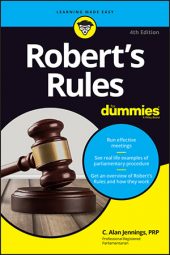Your favorite malcontent, Hugo Chump, moves to direct the treasurer to transfer the group’s funds to his investment brokerage company. You, along with the few good members who know better, are appalled, but you don’t have the votes to stop Hugo’s motion. What do you do?
By using the motion to Reconsider and Enter on the Minutes, you can prevent Hugo’s motion (if it’s adopted) from being put into effect until the more representative membership is again present to make a final decision.
As with the basic motion to Reconsider, you need to have voted on the prevailing side to make the motion to Reconsider and Enter on the Minutes, so you may have to hold your nose and cast your vote in favor of Hugo’s motion. And you still need a second. But after you make this motion, the action to transfer the money is on hold, and the other members have a chance to be informed of the issue so they can arrange to attend the next meeting. At that meeting, you can call up the motion to reconsider and hopefully undo Hugo’s little shenanigan.
- In a few departures from the usual rules for Reconsider, the motion to Reconsider and Enter on the Minutes
- Can be moved only on the same day on which the motion to be reconsidered was voted upon
- Outranks the regular motion to Reconsider
- Can be applied only to main motions finally disposed of, such as main motions that were adopted, or that failed, or that were postponed indefinitely
- Can’t be applied to a motion if the object of the motion would be harmed by the delay of a day (for example, a motion to hire a limousine to pick up the guest speaker at the airport tomorrow morning)
- Can’t be moved at the last meeting of a session if the next business meeting won’t be held within a quarterly time interval
- Can’t be called up on the day the motion’s made, unless it’s made on the last day of a session and called up at a later meeting on that same day

